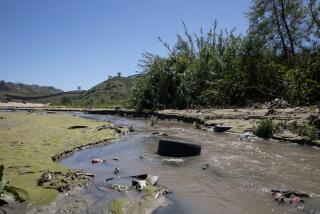Why All County Water Is Not Equal in Appearance and Smell
- Share via
Have you ever raised a glass of water to your lips only to say, “This looks like someone washed his socks in it”?
Or noticed that your tap water smelled a bit moldy? Or looked dirty? Or tasted like chalk? Or flowers?
Unless you have never met a glass of water you did not like, read on. This is for you--and everyone else who ever turned up a nose or looked askance at drinking water.
In addition to testing the county’s drinking water for taste (story on Page 1), The Times Orange County Edition collected official analyses of its two most noticeable traits--appearance and smell--from all 41 retail water agencies here. Retail water agencies are required periodically to judge the appearance and odor of their water and report certified findings under penalty of perjury to the state, said Frank Hamamura, district engineer for the public water supply branch of the state Department of Health Services.
You can find the results of each agency’s most recent analysis for color, odor and turbidity (clarity) on Page 2. The standard for comparison: perfectly clear and absolutely odorless water.
With just two exceptions, all the analyses submitted to The Times fell well within the state’s limits.
Results were too many to rank, but measurable differences can be discerned from one end of the county to another--and even within the same water district. For example, the analyses indicate that water in Tustin is not as clear as water in Huntington Beach. And it appears to be more difficult to smell the Moulton Niguel Water District’s product than San Clemente’s water.
The varying results can be traced to the differences in sources and blends of water, treatment procedures, ground-water conditions, types of delivery and storage facilities.
For example, sulfites in well water, algae growth in surface water, long retention in reservoirs or pipes and even temperature can affect taste, odor and appearance, said Marshall Davis, Metropolitan Water District laboratory manager.
When an MWD expert notes “a swampy, musty-type taste,” it may be caused by “a growth of algae at Lake Mathews reservoir,” Davis said.
Colorado River water can be high in such dissolved minerals as calcium, magnesium and sodium and leave a dryness in the mouth.
Sometimes a treatment to alleviate one problem simply causes another. Water treated with ozones to clear up a color or odor problem can develop a peculiar fruity taste as a side effect. One disinfectant used to make drinking water safe can leave an odor similar to geraniums.
About 40% of county water is provided by the Santa Ana River, Santiago Creek and San Juan Creek, which each carry upstream runoff, including treated effluent.
Utilities buy more water from the MWD to replenish the underground basin. The MWD, which also provides the county’s surface water and pipeline supplies, imports water from the Colorado River and upstate, via the California Water Project.
“In terms of aesthetic quality . . . the Metropolitan Water supplies are fairly good,” said Hamamura, the district engineer. “The chemicals they add--ammonia and chlorine--don’t (leave) a different taste or odor.”
Although county raw water supplies may contain higher mineral counts than Northern California’s, once treated it is basically the same as drinking water throughout the state, he said.
Some water retailers, such as the South Coast Water District, simply pass along the MWD-imported water virtually unchanged. Others, such as the Trabuco Canyon Water District, store it above the ground before piping it to consumers. Still others, such as La Palma, pay part of the cost to import water settled in underground water tables to replenish local wells.
Whatever their differences, the resulting water can inspire real loyalty among users. Christine McCracken, whose husband, Joseph, is a member of the board of directors of the single-well Eastside Water Assn., said they love their water “to the point that we take it on trips when we go up the coast.”
The McCrackens and their neighbors enjoy an added benefit: They can drink as much as they want without worrying about running up the water bill. Eastside households pay a flat $12 monthly.
More to Read
Sign up for Essential California
The most important California stories and recommendations in your inbox every morning.
You may occasionally receive promotional content from the Los Angeles Times.










